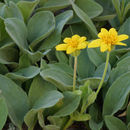Description
provided by eFloras
Plants 10–50 cm. Stems simple. Leaves 2–3 pairs, mostly cauline (basal leaves often persistent on sterile rosettes); petiolate (petioles narrowly to broadly winged); blades elliptic to ovate, 3–8 × 2–4 cm, margins entire or denticulate, apices acute to rounded, faces stipitate-glandular. Heads 1(–3). Involucres campanulate-turbinate. Phyllaries 10–16, oblanceolate. Ray florets 6–14; corollas yellow. Disc florets: corollas yellow; anthers yellow. Cypselae dark gray, 6–9 mm, stipitate-glandular; pappi white or tawny, bristles barbellate to subplumose. 2n = 76.
- license
- cc-by-nc-sa-3.0
- copyright
- Missouri Botanical Garden, 4344 Shaw Boulevard, St. Louis, MO, 63110 USA
Comprehensive Description
provided by North American Flora
Arnica nevadensis A. Gray, Proc. Am. Acad. 19: 55. 1883
Rootstock branched; stem 2-3 dm. high, striate, puberulent, somewhat glandular above; basal leaves and those of the offsets petioled, the petioles 3-5 cm. long, the blades firm, roundedovate or obovate, 3-5 cm. long, rounded at the apex, entire-margined, 3-5-ribbed, more or less densely puberulent; stem-leaves 2 or rarely 3 pairs, the lower similar to the basal ones, but petioles shorter, the upper ovate, sessile, 3-4 cm. long, those of the inflorescence linear-lanceolate ; heads 1-3, cymose; peduncles 5-10 cm. long; involucre turbinate, of the terminal head often 15 mm. high, and broad, of the lateral ones 12 mm., villous and glandular-puberulent ; bracts 8-10, lanceolate, acuminate; ray-flowers 8-12, the ligules 15-20 mm. long, 4—5 mm. wide, 5-7-veined; disk-corollas 6 mm. long; achenes 5 mm. long, striate, sparingly hirsutulous and glandulargranuliferous or glabrate; pappus-bristles straw-colored, 7 mm. long, short-plumose.
Type locality: Lassen's Peak, California. Distribution: Sierra Nevada of California and Nevada.
- bibliographic citation
- Per Axel Rydberg. 1927. (CARDUALES); CARDUACEAE; LIABEAE, NEUROLAENEAE, SENECIONEAE (pars). North American flora. vol 34(4). New York Botanical Garden, New York, NY
Comprehensive Description
provided by North American Flora
Arnica tomentella Greene, Pittonia 4: 166. 1900
Rootstock slender; stem 3-5 dm. high, puberulent, and glandular, especially on the peduncles; basal leaves several, long-petioled, the petioles 5-7 cm. long; blades ovate or oval, 5-ribbed, acute at the base, 5-7 cm. long, 2-3.5 cm. wide', finely and densely puberulent, almost tomentulose on both sides and glandular-granuliferous above, denticulate ; stem-leaves 3 or 4 pairs, the lowest pair similar to the basal ones, the next with short winged petioles, and the uppermost ovate or lanceolate, sessile, 2-4 cm. long; heads 1-3; involucre rounded-campanulate to hemispheric, 12-14 mm. high, 14-18 mm. broad, finely short-villous; bracts 9-12, oblanceolate, obtuse or acutish, 4-5 mm. long; ray-flowers 9-12, the ligules 13-15 mm. long, 3—4 mm. wide; disk-flowers 8 mm. long; achenes 6 mm. long, sparsely hirsute and glandulargranuliferous; pappus-bristles white, 8 mm. long, barbellate.
Tvpe locality: Middle Tule River, southeastern California. Distribution: Sierra Nevada. California.
- bibliographic citation
- Per Axel Rydberg. 1927. (CARDUALES); CARDUACEAE; LIABEAE, NEUROLAENEAE, SENECIONEAE (pars). North American flora. vol 34(4). New York Botanical Garden, New York, NY
Arnica nevadensis: Brief Summary
provided by wikipedia EN
Arnica nevadensis is a North American species of arnica in the sunflower family, known by the common names Nevada arnica and Sierra arnica. It is native to the coniferous forests of the western United States, primarily the Cascades and Sierra Nevada (Washington, Oregon, California, Nevada).
Arnica nevadensis is a perennial herb producing one or more hairy, glandular stems up to about 30 centimeters tall. There are two or three pairs of leaves along mainly the lower half of the stem, each oval in shape with the lowest up to 8 centimeters long.
The inflorescence holds one to three daisylike flower heads lined with phyllaries coated in glandular hairs. The flower head has a center of yellow disc florets and a fringe of yellow ray florets. The fruit is an achene with a white to cream-colored pappus.
- license
- cc-by-sa-3.0
- copyright
- Wikipedia authors and editors

